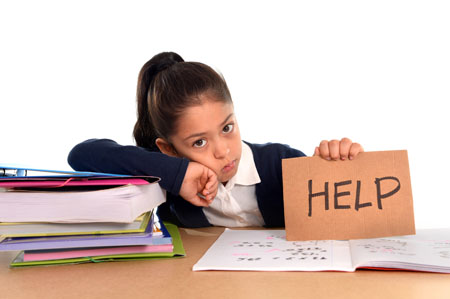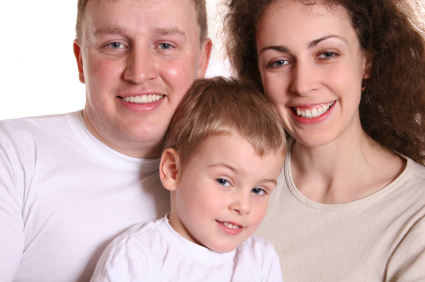Subthreshold Episodes of Mania Best Predictor of Bipolar Disorder in Children
Relatively little attention has been paid to the children of a parent with bipolar disorder, who are at risk not only for the onset of bipolar disorder, but also anxiety, depression, and multiple other disorders. These children deserve a special focus, as on average 74.2% will receive a major (Axis 1) psychiatric diagnosis within seven years.
New research published by David Axelson and colleagues in the American Journal of Psychiatry describes a longitudinal study comparing children who have a parent with bipolar disorder to demographically matched children in the general public. Offspring at high risk for bipolar disorder because they have a parent with the disorder had significantly higher rates of subthreshold mania or hypomania (13.3% versus 1.2%) or what is known as bipolar disorder not otherwise specified (BP-NOS); manic, mixed, or hypomanic episodes (9.2% versus 0.8%); major depressive episodes (32.0% versus 14.9%); and anxiety disorders (39.9% versus 21.8%) than offspring of parents without bipolar disorder. Subthreshold episodes of mania or hypomania (those that resemble but do not meet the full requirements for bipolar disorder in terms of duration) were the best predictor of later manic episodes. This finding was observed prospectively, meaning that patients who were diagnosed with manic episodes during a follow-up assessment were likely to have been diagnosed with a subthreshold manic or hypomanic episode during a previous assessment.
The study included 391 children (aged 6–18) of at least one bipolar parent, and compared these to 248 children of parents without bipolar disorder in the community. The participants took part in follow-up assessments every 2.5 years on average, for a total of about 6.8 years. Each follow-up assessment included retrospective analysis of symptoms that had occurred since the previous assessment.
In addition to having more subthreshold manic or hypomanic episodes; manic, mixed, or hypomanic episodes; and major depressive episodes, the high-risk children also showed more non-mood-related axis 1 disorders, including attention deficit hyperactivity disorder (ADHD), disruptive behavior disorders, and anxiety disorders than the children of parents without bipolar disorder. Axelson suggested that monitoring for these symptoms may help with early identification and treatment.
Children with a bipolar parent were diagnosed with bipolar spectrum disorders at rates of 23% compared to 3.2% in the comparison offspring. Mean age of onset of mania or hypomania in the high-risk offspring was 13.4 years. Of those offspring who had a manic episode, more than half had the episode before age 12, with the earliest occurring at age 8.1.
Compared to previous studies of children of parents with bipolar disorder, this study found that the mean age of onset of manic or hypomanic episodes was younger, possibly because other studies did not include young children. Another new finding was that major depressive episodes were risk factors for mania and hypomania but did not always precede the onset of mania or hypomania in the high-risk offspring.
Parents of children who are at high risk for developing bipolar spectrum disorders should be aware of the common precursors to mania—subthreshold manic or hypomanic symptoms and non-mood disorders—and make sure that clinicians assess for these symptoms and differentiate them from the symptoms of depression or other disorders.
Editor’s Note: In Axelson’s study, 74.2% of the offspring of a bipolar parent suffered a major (Axis I) psychiatric disorder. However, 48.4% of the offspring from the comparison group of community controls also had an Axis 1 psychiatric disorder. These high rates of illness and dysfunction indicate the importance of monitoring a variety of symptom areas and getting appropriate evaluation and treatment in the face of symptoms that are associated with impairment in both high risk children and in the general population.
One way of doing this is for parents to join our new Child Network, a study collecting information about how children at risk for bipolar disorder or with symptoms of bipolar disorder are being treated in the community and how well they are doing. Parents rate their children on a weekly basis for depression, anxiety, ADHD, oppositionality, and mania-like symptoms. Parents will be able to produce a longitudinal chart of their children’s symptoms and response to treatment, which may assist their child’s physician with early detection of illness and with treatment. See here for more information and to access informed consent documents.
Korean Study of Mental Disorders in Children of Bipolar Parents
Korea, like the US, has a moderate incidence of childhood-onset bipolar disorder among children who are at high risk because they have a parent with bipolar disorder. In a recent study by Young-Sun Cho et al. presented at the 2014 meeting of the International College of Neuropsychopharmacology (CINP), 59 out of 100 children with a parent who had been diagnosed with bipolar disorder met the criteria for a mental disorder themselves.
Mood disorders were most common. Of the 59 children with mental disorders, 22 were diagnosed with bipolar disorder, and 16 were diagnosed with a depressive disorder. Others included four with attention deficit hyperactivity disorder (ADHD), four with an anxiety disorder, two with disruptive behavior disorders, one with a tic disorder, one with an autistic disorder, and one with schizophrenia and an anxiety disorder.
Editor’s Note: In contrast to studies in Germany, Switzerland, the Netherlands, and Canada, where few children are diagnosed with bipolar disorders (even among those who are at high risk because of a family history of bipolar disorder), 22% of high-risk children in Korea were diagnosed with bipolar disorder. This is comparable to or higher than rates at which high-risk children in the US are diagnosed with bipolar disorder. Studies from both the Bipolar Collaborative Network (in which this editor Robert Post is an investigator) and researcher Boris Birmaher et al. found that parents with bipolar disorder often had a variety of other disorders, such as anxiety, alcohol abuse, or substance abuse. These other illnesses also increase the risk of early-onset bipolar disorder in offspring, and this may account for the higher incidence of early-onset bipolar disorder among high-risk children in the US.
Children of Bipolar Parents Are At Risk for Depression and Bipolar Disorder
The Pittsburgh Bipolar Offspring study, led by Boris Birmaher of the University of Pittsburgh, investigated risk of illness in the offspring of parents with bipolar disorder. The study included 233 parents with bipolar disorder and 143 controls. In addition to bipolar disorder, parents in the study had many other disorders, including anxiety (70%), panic (40%), a disruptive behavior disorder (35%), attention-deficit hyperactivity disorder or ADHD (25%), and substance use disorder (35%).
The offspring averaged age 12 at entry in the study. Offspring of parents with bipolar disorder had more illness than those of control parents, including bipolar spectrum disorders (10.6% versus 0.8%), depression (10.6% versus 3.6%), anxiety disorder (25.8% versus 10.8%), oppositional defiant disorder or conduct disorder (19.1% versus 8.0%), and ADHD (24.5% versus 6.7%). Of these differences, only bipolar spectrum disorders and anxiety were statistically significant after correcting for differences in the parents’ other diagnoses.
Two factors predicted bipolar spectrum disorders in the offspring: younger age of a parent at birth of child and bipolar disorder in both parents. Older children and those with diagnoses of anxiety or oppositional defiant disorder were more likely to be diagnosed with bipolar disorder.
On long-term follow-up that continued on average until the offspring reached age 20, 23% of those participants who had a parent with bipolar disorder developed any type of bipolar disorder, versus only 1.2% of the children of controls. Of these 23%, about two-thirds had a depressive episode prior to the onset of their bipolar disorder.
Of the offspring of parents with bipolar disorder who developed a bipolar spectrum illness, 12.3% developed bipolar I or II disorders, while 10.7% were diagnosed with bipolar not otherwise specified (NOS). Of those with bipolar NOS, which some consider to be sub-threshold bipolar disorder, about 45% converted to a bipolar I or II diagnosis after several years of prospective follow-up. These data, along with the finding that children with bipolar NOS are highly impaired and take more than a year on average to remit, stress the importance of vigorously treating this subtype, even if it does not meet the full threshold for bipolar I or bipolar II.
Birmaher indicated that although about 50% of the offspring of a bipolar patient had no diagnosis, the high incidence of multiple psychiatric difficulties developing over childhood and adolescence spoke to the importance of attempts at early intervention and prevention. Studies of effective treatment and prevention strategies are desperately needed. So far only family focused therapy (FFT), an intervention developed by researcher David Miklowitz, has shown significant benefits over standard treatment in children with a positive family history of bipolar disorder who already have a diagnosis of anxiety, depression, or bipolar not otherwise specified.
Transgenerational Transmission of PTSD
At a recent scientific meeting, Rachael Yehada showed that PTSD-like traits could be passed transgenerationally. Mothers in New York City who were pregnant on September 11, 2001 and developed post-traumatic stress disorder (PTSD) produced children with low cortisol in their blood (a sign of PTSD). If the fathers had PTSD during the mother’s pregnancy, the children had high cortisol.
These gender-related findings have some parallels in studies of rodents. When a rat pup is separated from its mother for 15 minutes, the mother is overjoyed to see the pup return and licks and grooms it excessively. This maternal overprotection yields an animal with lifelong low cortisol through an epigenetic process. The glucocorticoid receptor gives a feedback message to suppress cortisol, and glucocorticoid receptors are increased in the pups’ brains because of lower methylation of the DNA promoter for glucocorticoid receptors.
If a father has PTSD, there is more methylation of the promoter for glucocorticoid receptors and less expression of them in the forebrain. There is also less feedback suppression of cortisol and the baby exhibits high cortisol.
The methylation of the glucocorticoid receptors in the offspring’s white blood cells is highly correlated (r=0.57, p<0.005, n=23) with methylation in the parent’s white blood cells.
Loss of Appetite or Weight in Depressed Parents Predicts Depression in Children
 Depression in a parent is one of the factors that best predicts whether a young person will develop depression. Since depression symptoms can vary greatly from person to person and some symptoms are known to be more heritable than others, new research is investigating whether a parent’s profile of symptoms affects their child’s likelihood of developing the illness. A 2013 study by Mars et al. in the Journal of Clinical Psychiatry suggests that loss of appetite or weight in a parent with depression is the symptom that most strongly predicts new onset of depression and depressive symptoms in their offspring.
Depression in a parent is one of the factors that best predicts whether a young person will develop depression. Since depression symptoms can vary greatly from person to person and some symptoms are known to be more heritable than others, new research is investigating whether a parent’s profile of symptoms affects their child’s likelihood of developing the illness. A 2013 study by Mars et al. in the Journal of Clinical Psychiatry suggests that loss of appetite or weight in a parent with depression is the symptom that most strongly predicts new onset of depression and depressive symptoms in their offspring.
The study observed 337 parent-child pairs. The parents (mostly mothers), who had a history of recurrent unipolar depression, ranged in age from 25–55 years, and their children ranged from 9–17 years. The study lasted four years, during which the families participated in three assessments. Parents’ symptoms were recorded and children were also assessed for symptoms or new development of depression. Thirty percent of the offspring whose parents reported weight loss or low appetite were found to have new onset of depression at followup, compared to nine percent of the offspring whose parents did not have these symptoms.
There are nine symptoms used to diagnose depression in the Diagnostic and Statistical Manual for Mental Disorders: low mood, loss of interest (anhedonia), loss of energy, change in appetite or weight, change in sleep, low self-esteem or guilt, suicidality, psychomotor slowing (retardation), and loss of concentration or indecisiveness. Of these, parental loss of appetite or weight was the only symptom that predicted depression in a child. Interestingly, the severity of parental depression or the presence of other health problems in the parent did not account for the emergence of illness in the children.
Suggestions for Physicians Treating Parents with Bipolar Disorder
- Support Pregnant Women with Bipolar Disorder
A. Depression during pregnancy is more common among women with bipolar disorder than among controls–consider cognitive behavioral therapy, omega-3 fatty acids, folate, & rTMS
B. 52% incidence of post-partum depression (3x higher than controls)–Monitor closely and treat accordingly - Ask Your Affectively Ill Patients About Their Children
- Encourage Good Diet and Exercise in These Children
- Encourage Watchful Waiting in Families with Children at High Risk
- If a Child becomes Symptomatic, Suggest:
A. Family Focused Therapy (FFT), or other Family-Based Treatment
B. Low-Risk Interventions Like Nutrition and Sleep Hygiene - If a Child Develops BP-NOS, Encourage:
A. Mainstream Pharmacotherapy
B. Increased Social Support (Family, Friends, Advocacy) - If a Child Develops BP-I, Encourage Ongoing Monitoring & Medication
- If an Adolescent Becomes Manic, Educate About Substance Abuse and Attempt Primary Prevention of a Substance Abuse Disorder
Parental Nurturing Linked to Greater Hippocampal Volume in Young Children
An article published by Medscape reports that in a recent study by Dr. Joan Luby of Washington University School of Medicine in St. Louis, non-depressed preschool children whose parents showed more nurturing behaviors during a mildly stressful task were found to have hippocampal volume almost 10% greater than their peers whose parents showed fewer nurturing behaviors. The hippocampus affects cognitive functioning and emotion regulation.
Unfortunately, parental nurturing did not effect the hippocampal volume of children with early-onset depression.
Dr. Luby and colleagues think their findings could have “profound public health implications and suggest that greater public health emphasis on early parenting could be a very fruitful social investment.”
“The finding that early parenting support, a modifiable psychosocial factor, is directly related to healthy development of a key brain region known to impact cognitive functioning and emotion regulation opens an exciting opportunity to impact the development of children in a powerful and positive fashion”.







